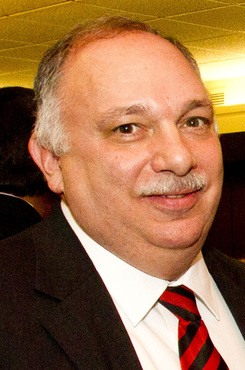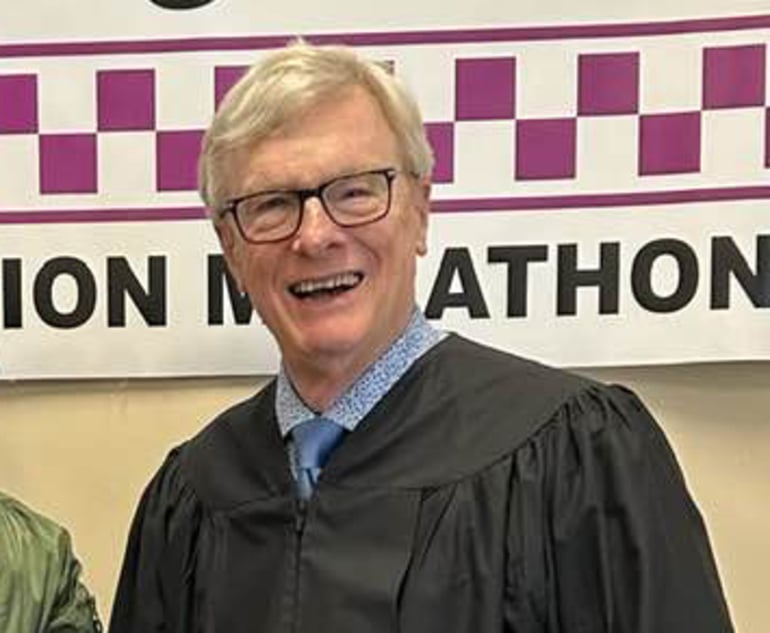Jury Clears Defendants in 2013 Plane Crash That Killed 5
The jury heard the first of five cases stemming from the 2013 crash of a corporate jet at Thomson-McDuffie Airport.
August 17, 2018 at 05:55 PM
5 minute read
 Judge Jay Roth (Photo: John Disney/ ALM)
Judge Jay Roth (Photo: John Disney/ ALM)The story below was written Friday afternoon, after the jury had begun deliberating but before it returned its verdict. After the story was published the Daily Report learned that the jury issued a complete defense verdict, clearing Milliken & Co. of liability. Defense lawyer Laurie Webb Daniel said the jury never reached the apportionment issue.
The Daily Report will have more concerning the case and verdict on Monday.
A Fulton County jury has retired to consider whether global textile and chemical giant Milliken & Co. is liable for a 2013 airplane crash at Thomson-McDuffie Airport that killed five people after an executive jet struck a power pole on the company's property just beyond the end of the runway.
Lawyers in the hard-fought case continued to file supplemental jury charges right until closing arguments, with an exasperated Judge Jay Roth emerging from his chambers to admonish both sides before the jury was ushered in.
“Stop filing, just stop filing,” Roth said. ”It's not going to happen.”
That didn't stop continued sparring over the terms of more than two dozen jury charges, with Roth saying the last-minute requests should have been hammered out weeks ago.
The case, the first of five stemming from the crash, concerns the death of Heidi McCorkle, a 28-year-old mother who worked for the doctor whose practice owned the plane.
The crash also killed vascular surgeon Steven Roth and employees Lisa Volpitto, Tiffany Porter and Kim Davidson.
The crash occurred when the jet was flying into Thomson-McDuffie at night as the group returned from Nashville, Tennessee. The pilot and co-pilot of the Hawker Beechcraft Premier were the only survivors.
Lead plaintiffs' Nicholas Moraitakis said Milliken, which granted an easement to the airport in 1972 and later had Georgia Power erect the pole for a plant expansion, knew for years the pole was a hazard to aircraft.
A company memo from a 1989 meeting about the project revealed that a Milliken official was concerned about building “smack dab at the end of the runway” and that any obstruction must be no higher than 50 feet.
But when Georgia Power installed a 72-foot pole, “Milliken did nothing about it,” said the Moraitakis and Kushel partner, who is representing McCorkle's husband and estate with firm colleague Martha Turner; William Stone and James Stone of the Stone Law Group; Joseph Brown of Mobile, Alabama's Cunningham Bounds; and John Clark of Macon's Clark & Smith.
Lead defense attorney Pete DeMahy of Coral Gables' DeMahy, Labrador, Drake, Victor, Rojas & Cabeza said there was no such “agreement” and noted that the airport authority, Federal Aviation Administration, Georgia Department of Transportation and Georgia Power had all allowed the pole to stay where it was—and where it remains today.
“We're making fabric,” DeMahy said. “And we're supposed to know more than the aviation authorities?”
DeMahy said the evidence showed that, even if the pole were 50 feet tall, the plane still would have crashed, because its pilot committed multiple errors before and after he aborted a landing and clipped a tree and guy wires anchoring the pole.
“Even if the pole hadn't been there, that flight was doomed,” DeMahy said, pointing to an investigation by a defense expert that indicated a piece of the plane's wing lodged under a bracket on the pole about 58 feet above the ground was thrown upward as the aircraft—already missing half a wing—rolled over and passed it.
The fault, he said, rested with pilot Richard Trammell, who survived the crash along with his co-pilot and who testified that he knew the pole was there and had made several errors, including not responding to a warning klaxon indicating the plane was not configured properly to take off again.
“He was so out of it he didn't even notice the horn going off in his face,” DeMahy said, referring to testimony that the pilot only had five hours of sleep in the 24 hours preceding the crash.
Noting that multiple other defendants were originally in the complaint, including Georgia Power, Trammell and the airport authority, “everybody else” also bears responsibility, said DeMahy, representing Milliken with firm partner Orlando Cabeza, Stevan Miller and Lisa Richardson of Drew Eckl & Farnham and Laurie Webb Daniel of Holland & Knight.
Rising to wrap up, Moraitakis conceded that other parties might have contributed to the incident, but Milliken had a non-delegable duty under the easement to keep the flight path safe.
It was Milliken and Trammell that caused the crash, he said, but Trammell only had “minutes, or seconds” to correct his error.
“Milliken had 24 years,” he said, urging to jury to find the pilot liable for only 1 or 5 percent of negligence, if any.
Rott allowed the other parties originally charged in the case to be added to the jury form for apportionment purposes, and Moraitakis urged the jury to find no liability on their part.
In assessing damages, he suggested $3.3 million for the value of McCorkle's lost wages and $15 million for the value of her life.
This content has been archived. It is available through our partners, LexisNexis® and Bloomberg Law.
To view this content, please continue to their sites.
Not a Lexis Subscriber?
Subscribe Now
Not a Bloomberg Law Subscriber?
Subscribe Now
NOT FOR REPRINT
© 2025 ALM Global, LLC, All Rights Reserved. Request academic re-use from www.copyright.com. All other uses, submit a request to [email protected]. For more information visit Asset & Logo Licensing.
You Might Like
View All
Carrier Legal Chief Departs for GC Post at Defense Giant Lockheed Martin

Trending Stories
- 1Uber Files RICO Suit Against Plaintiff-Side Firms Alleging Fraudulent Injury Claims
- 2The Law Firm Disrupted: Scrutinizing the Elephant More Than the Mouse
- 3Inherent Diminished Value Damages Unavailable to 3rd-Party Claimants, Court Says
- 4Pa. Defense Firm Sued by Client Over Ex-Eagles Player's $43.5M Med Mal Win
- 5Losses Mount at Morris Manning, but Departing Ex-Chair Stays Bullish About His Old Firm's Future
Who Got The Work
J. Brugh Lower of Gibbons has entered an appearance for industrial equipment supplier Devco Corporation in a pending trademark infringement lawsuit. The suit, accusing the defendant of selling knock-off Graco products, was filed Dec. 18 in New Jersey District Court by Rivkin Radler on behalf of Graco Inc. and Graco Minnesota. The case, assigned to U.S. District Judge Zahid N. Quraishi, is 3:24-cv-11294, Graco Inc. et al v. Devco Corporation.
Who Got The Work
Rebecca Maller-Stein and Kent A. Yalowitz of Arnold & Porter Kaye Scholer have entered their appearances for Hanaco Venture Capital and its executives, Lior Prosor and David Frankel, in a pending securities lawsuit. The action, filed on Dec. 24 in New York Southern District Court by Zell, Aron & Co. on behalf of Goldeneye Advisors, accuses the defendants of negligently and fraudulently managing the plaintiff's $1 million investment. The case, assigned to U.S. District Judge Vernon S. Broderick, is 1:24-cv-09918, Goldeneye Advisors, LLC v. Hanaco Venture Capital, Ltd. et al.
Who Got The Work
Attorneys from A&O Shearman has stepped in as defense counsel for Toronto-Dominion Bank and other defendants in a pending securities class action. The suit, filed Dec. 11 in New York Southern District Court by Bleichmar Fonti & Auld, accuses the defendants of concealing the bank's 'pervasive' deficiencies in regards to its compliance with the Bank Secrecy Act and the quality of its anti-money laundering controls. The case, assigned to U.S. District Judge Arun Subramanian, is 1:24-cv-09445, Gonzalez v. The Toronto-Dominion Bank et al.
Who Got The Work
Crown Castle International, a Pennsylvania company providing shared communications infrastructure, has turned to Luke D. Wolf of Gordon Rees Scully Mansukhani to fend off a pending breach-of-contract lawsuit. The court action, filed Nov. 25 in Michigan Eastern District Court by Hooper Hathaway PC on behalf of The Town Residences LLC, accuses Crown Castle of failing to transfer approximately $30,000 in utility payments from T-Mobile in breach of a roof-top lease and assignment agreement. The case, assigned to U.S. District Judge Susan K. Declercq, is 2:24-cv-13131, The Town Residences LLC v. T-Mobile US, Inc. et al.
Who Got The Work
Wilfred P. Coronato and Daniel M. Schwartz of McCarter & English have stepped in as defense counsel to Electrolux Home Products Inc. in a pending product liability lawsuit. The court action, filed Nov. 26 in New York Eastern District Court by Poulos Lopiccolo PC and Nagel Rice LLP on behalf of David Stern, alleges that the defendant's refrigerators’ drawers and shelving repeatedly break and fall apart within months after purchase. The case, assigned to U.S. District Judge Joan M. Azrack, is 2:24-cv-08204, Stern v. Electrolux Home Products, Inc.
Featured Firms
Law Offices of Gary Martin Hays & Associates, P.C.
(470) 294-1674
Law Offices of Mark E. Salomone
(857) 444-6468
Smith & Hassler
(713) 739-1250








